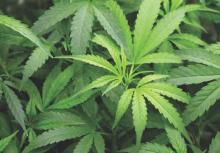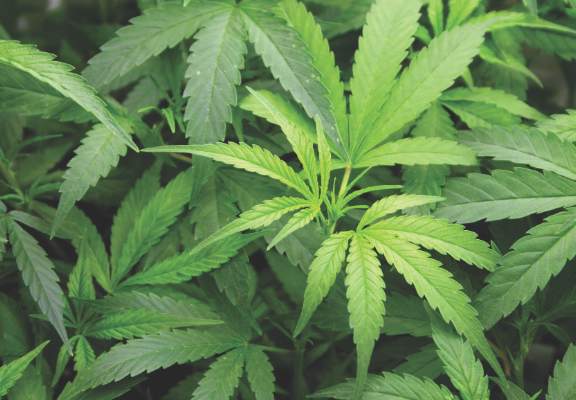User login
Marijuana use was higher in states that legalized treatment of medical conditions with marijuana, but the increased use was present both before and after such laws were passed, according to annual, repeated cross-sectional surveys.
“[T]he overall effect of medical marijuana laws on adolescent use before versus after passage of the law remained nonsignificant, although (as for the overall results), use was significantly reduced in 8th- but not for 10th- or 12th-graders,” noted Dr. Deborah S. Hasin, professor of epidemiology (in psychiatry) at Columbia University Medical Center, New York, and her colleagues.
The findings were based on responses to surveys from 1,098,270 students in the 8th, 10th, and 12th grades between 1991 and 2014. Respondents were from the 48 contiguous states, 21 of which had passed medical marijuana laws by 2014. Mean response rates for 1991-2013 were 81%-91% for almost all years and grades.
Students were asked if they had used marijuana in the previous 30 days; 15.87% of them said they had, in states that had passed a medical marijuana law between 1991 and 2014. In states that had not passed that type of a law, the prevalence of marijuana use was 13.27%.
The study showed no evidence for an increase in adolescent use of marijuana in the year of passage of a medical marijuana law, or in the first or second years after passage.
Prior to passage of a law permitting the use of marijuana for medicinal purposes, 16.25% of the survey’s participants said they had used marijuana within the previous 30 days. Following such legislative changes, the prevalence of use was 15.45%.
“Our two main findings, in conjunction with other evidence, suggest that state-level factors other than medical marijuana laws influence adolescent marijuana use,” the researchers wrote.
Dr. Hasin and her colleagues declared no conflicts of interest.
Read the full study here.
Marijuana use was higher in states that legalized treatment of medical conditions with marijuana, but the increased use was present both before and after such laws were passed, according to annual, repeated cross-sectional surveys.
“[T]he overall effect of medical marijuana laws on adolescent use before versus after passage of the law remained nonsignificant, although (as for the overall results), use was significantly reduced in 8th- but not for 10th- or 12th-graders,” noted Dr. Deborah S. Hasin, professor of epidemiology (in psychiatry) at Columbia University Medical Center, New York, and her colleagues.
The findings were based on responses to surveys from 1,098,270 students in the 8th, 10th, and 12th grades between 1991 and 2014. Respondents were from the 48 contiguous states, 21 of which had passed medical marijuana laws by 2014. Mean response rates for 1991-2013 were 81%-91% for almost all years and grades.
Students were asked if they had used marijuana in the previous 30 days; 15.87% of them said they had, in states that had passed a medical marijuana law between 1991 and 2014. In states that had not passed that type of a law, the prevalence of marijuana use was 13.27%.
The study showed no evidence for an increase in adolescent use of marijuana in the year of passage of a medical marijuana law, or in the first or second years after passage.
Prior to passage of a law permitting the use of marijuana for medicinal purposes, 16.25% of the survey’s participants said they had used marijuana within the previous 30 days. Following such legislative changes, the prevalence of use was 15.45%.
“Our two main findings, in conjunction with other evidence, suggest that state-level factors other than medical marijuana laws influence adolescent marijuana use,” the researchers wrote.
Dr. Hasin and her colleagues declared no conflicts of interest.
Read the full study here.
Marijuana use was higher in states that legalized treatment of medical conditions with marijuana, but the increased use was present both before and after such laws were passed, according to annual, repeated cross-sectional surveys.
“[T]he overall effect of medical marijuana laws on adolescent use before versus after passage of the law remained nonsignificant, although (as for the overall results), use was significantly reduced in 8th- but not for 10th- or 12th-graders,” noted Dr. Deborah S. Hasin, professor of epidemiology (in psychiatry) at Columbia University Medical Center, New York, and her colleagues.
The findings were based on responses to surveys from 1,098,270 students in the 8th, 10th, and 12th grades between 1991 and 2014. Respondents were from the 48 contiguous states, 21 of which had passed medical marijuana laws by 2014. Mean response rates for 1991-2013 were 81%-91% for almost all years and grades.
Students were asked if they had used marijuana in the previous 30 days; 15.87% of them said they had, in states that had passed a medical marijuana law between 1991 and 2014. In states that had not passed that type of a law, the prevalence of marijuana use was 13.27%.
The study showed no evidence for an increase in adolescent use of marijuana in the year of passage of a medical marijuana law, or in the first or second years after passage.
Prior to passage of a law permitting the use of marijuana for medicinal purposes, 16.25% of the survey’s participants said they had used marijuana within the previous 30 days. Following such legislative changes, the prevalence of use was 15.45%.
“Our two main findings, in conjunction with other evidence, suggest that state-level factors other than medical marijuana laws influence adolescent marijuana use,” the researchers wrote.
Dr. Hasin and her colleagues declared no conflicts of interest.
Read the full study here.
FROM THE LANCET PSYCHIATRY

